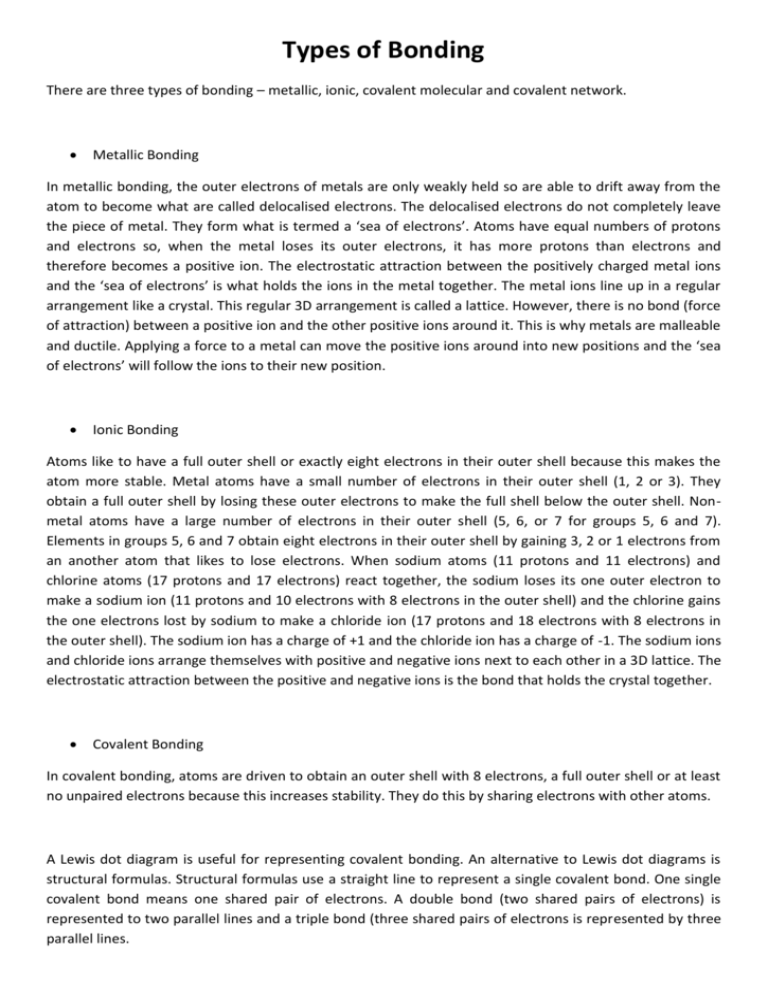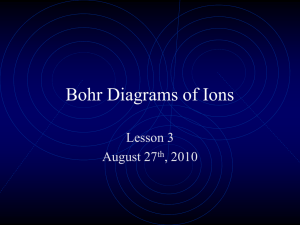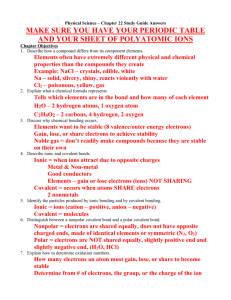Types of Bonding
advertisement

Types of Bonding There are three types of bonding – metallic, ionic, covalent molecular and covalent network. Metallic Bonding In metallic bonding, the outer electrons of metals are only weakly held so are able to drift away from the atom to become what are called delocalised electrons. The delocalised electrons do not completely leave the piece of metal. They form what is termed a ‘sea of electrons’. Atoms have equal numbers of protons and electrons so, when the metal loses its outer electrons, it has more protons than electrons and therefore becomes a positive ion. The electrostatic attraction between the positively charged metal ions and the ‘sea of electrons’ is what holds the ions in the metal together. The metal ions line up in a regular arrangement like a crystal. This regular 3D arrangement is called a lattice. However, there is no bond (force of attraction) between a positive ion and the other positive ions around it. This is why metals are malleable and ductile. Applying a force to a metal can move the positive ions around into new positions and the ‘sea of electrons’ will follow the ions to their new position. Ionic Bonding Atoms like to have a full outer shell or exactly eight electrons in their outer shell because this makes the atom more stable. Metal atoms have a small number of electrons in their outer shell (1, 2 or 3). They obtain a full outer shell by losing these outer electrons to make the full shell below the outer shell. Nonmetal atoms have a large number of electrons in their outer shell (5, 6, or 7 for groups 5, 6 and 7). Elements in groups 5, 6 and 7 obtain eight electrons in their outer shell by gaining 3, 2 or 1 electrons from an another atom that likes to lose electrons. When sodium atoms (11 protons and 11 electrons) and chlorine atoms (17 protons and 17 electrons) react together, the sodium loses its one outer electron to make a sodium ion (11 protons and 10 electrons with 8 electrons in the outer shell) and the chlorine gains the one electrons lost by sodium to make a chloride ion (17 protons and 18 electrons with 8 electrons in the outer shell). The sodium ion has a charge of +1 and the chloride ion has a charge of -1. The sodium ions and chloride ions arrange themselves with positive and negative ions next to each other in a 3D lattice. The electrostatic attraction between the positive and negative ions is the bond that holds the crystal together. Covalent Bonding In covalent bonding, atoms are driven to obtain an outer shell with 8 electrons, a full outer shell or at least no unpaired electrons because this increases stability. They do this by sharing electrons with other atoms. A Lewis dot diagram is useful for representing covalent bonding. An alternative to Lewis dot diagrams is structural formulas. Structural formulas use a straight line to represent a single covalent bond. One single covalent bond means one shared pair of electrons. A double bond (two shared pairs of electrons) is represented to two parallel lines and a triple bond (three shared pairs of electrons is represented by three parallel lines. The structural formula is easy to draw and is an aid to drawing Lewis dot diagrams. However, the structural formula only shows shared electron pairs and not all electrons in the outer shell so is not totally equivalent to a Lewis dot diagram. With structural formulas, remember that carbon and silicon always form 4 bonds, hydrogen always forms 1 bond, group 7 elements almost always form 1 bond, oxygen and sulfur generally form 2 bonds and nitrogen generally forms 3 bonds. This rule relates to the group in the Periodic Table. Classifying Compounds by Their Type of Bonding Type of Bonding Metallic Ionic Covalent Molecular Covalent Network How to Identify Contains only metals. Either a pure metal or an alloy. A compound of a metal and a non-metal. The metal may be replaced by a polyatomic cation such as ammonium (NH4+). A compound of non-metals only other than the small number of covalent network substances. There are not many examples of substances with covalent network bonding. Elemental silicon or carbon (diamond, graphite, Buckminsterfullerene). Silicon dioxide (quartz a.k.a. sand). Boron nitride (BN) and silicon carbide (SiC).



